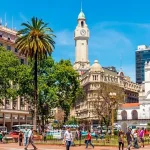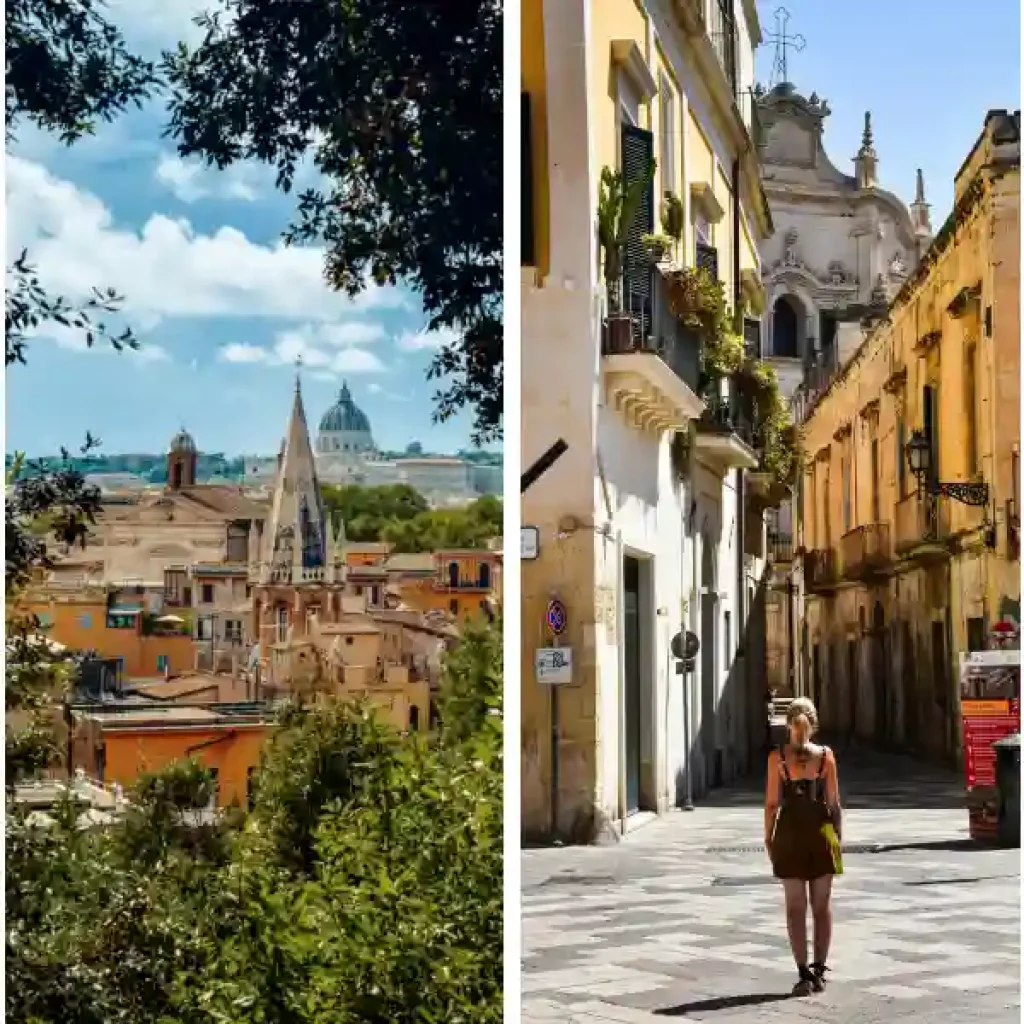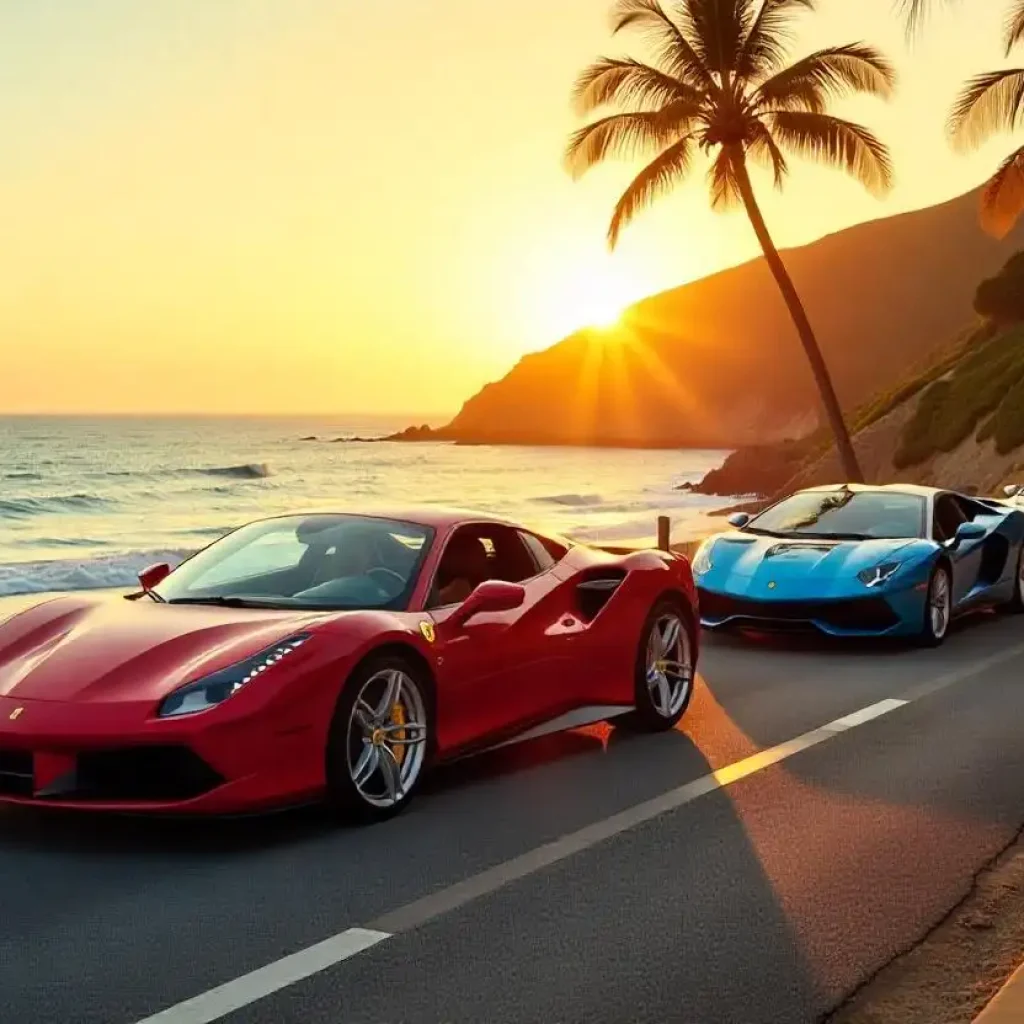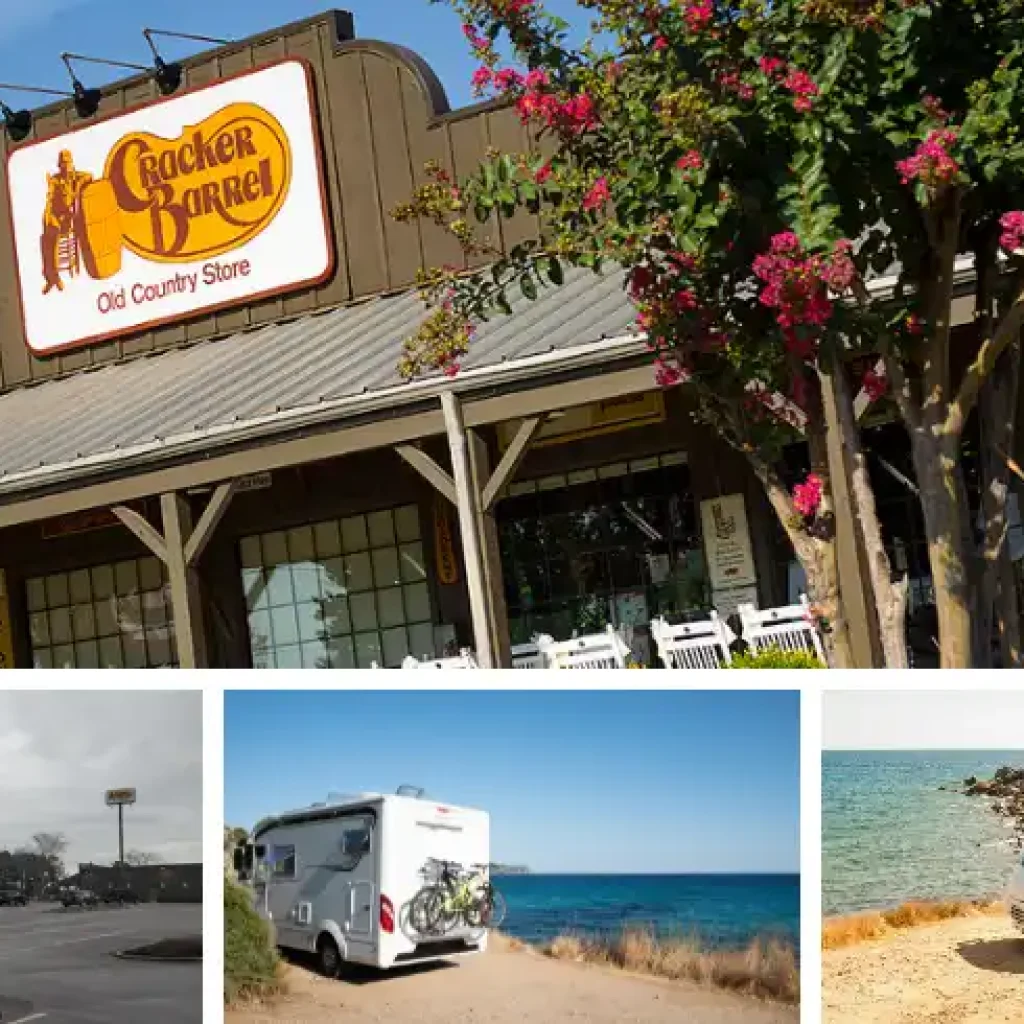How Much Is Elephant Safari in Kanha National Park?
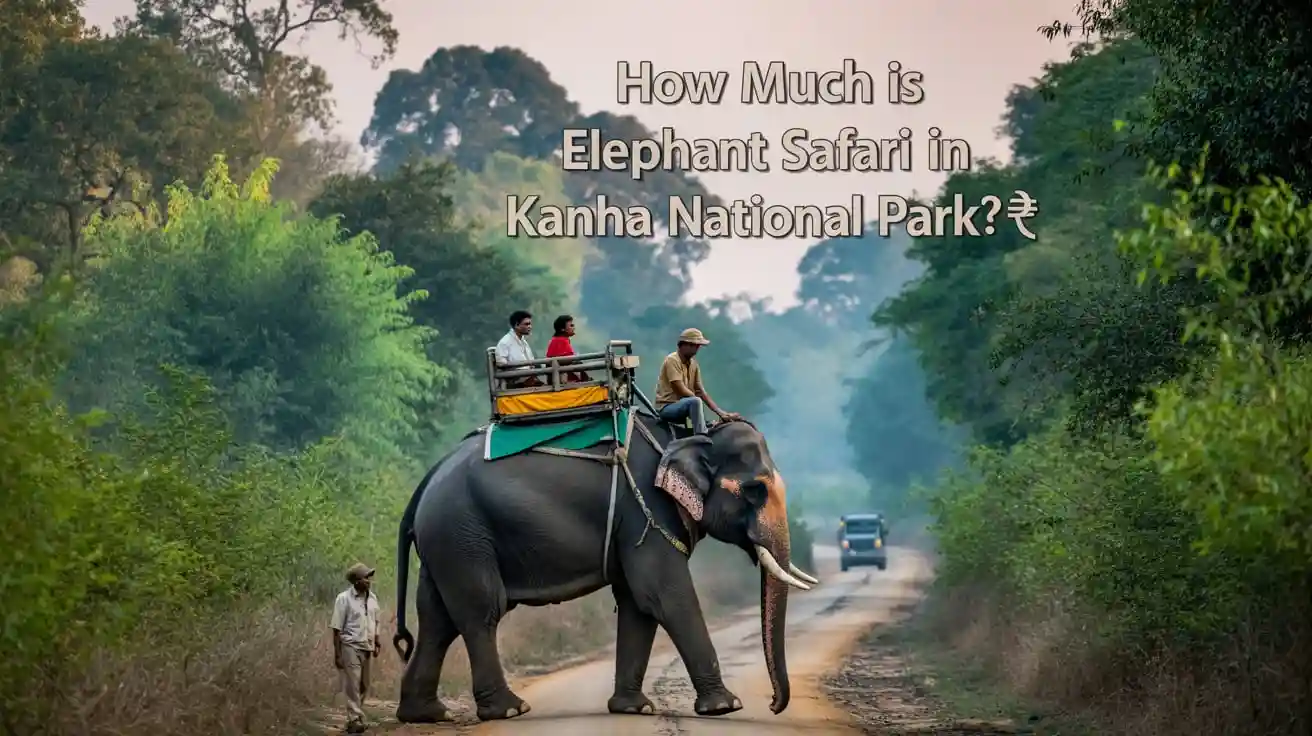
Picture this: mist curling over tall sal trees, a golden shaft of sunlight cutting through the forest, and the soft, almost soundless steps of an elephant moving under you. No engine noise. No rush. Just the wild breathing around you. That’s the magic of an elephant safari — and honestly, it’s one of the most unforgettable ways to experience Kanha.
If you’re wondering how much is elephant safari in Kanha National Park, you’re not alone. Travelers ask this all the time, especially those dreaming of close tiger encounters and those quiet moments deep in the jungle.
The thing is, it’s not just about the cost — though we’ll cover that in detail. It’s about access, exclusivity, and a kind of raw connection you don’t get from a jeep ride.
In this guide, we’ll answer the big question — how much is elephant safari in Kanha National Park, yes — but also when and where it’s available, what makes it unique, and why some people say it’s worth every rupee.
What Is an Elephant Safari in Kanha?
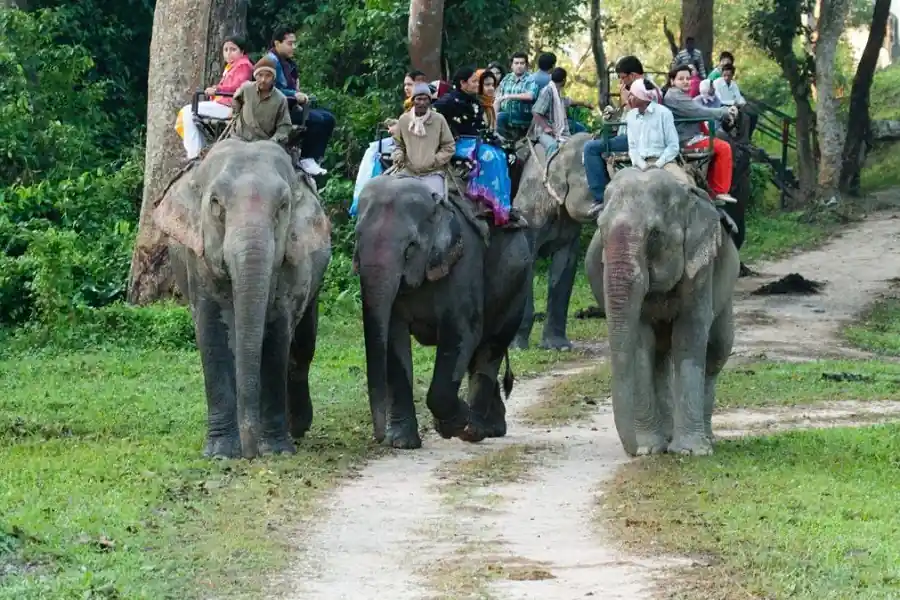
An elephant safari in Kanha isn’t a theme park ride. It’s not flashy. In fact, it’s a little old-school — a bit rough, slightly unpredictable, and deeply quiet. You sit atop a giant creature, with a trained mahout guiding it through forest trails that jeeps can’t reach.
No rumbling engine, no radio chatter. Just the sounds of the jungle and the occasional grunt from your elephant companion.
This kind of safari is mostly used for tiger tracking. When tigers are spotted during early morning jeep rides, forest officials sometimes dispatch elephants to get researchers — and occasionally tourists — closer without disturbing the animal.
That’s when you might get lucky and be offered a spot. So yeah… you don’t always get to plan it in advance. And that unpredictability is part of the deal.
Historically, these safaris were more common. But with growing awareness around elephant welfare and changing tourism policies, they’ve become rare — and a bit special. They’re only available in limited zones, and only when certain conditions line up. But when they do… you’re in for something remarkable.
Where and When Are Elephant Safaris Available in Kanha?
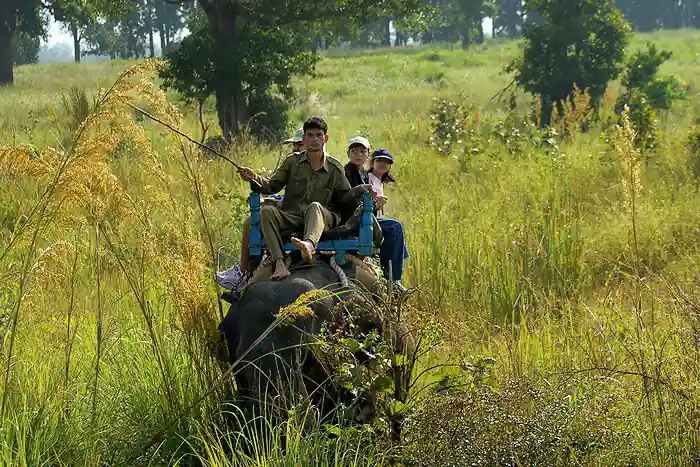
You won’t find elephant safaris in every corner of the park. Most of the time, they operate out of the Mukki and Kisli zones, which are part of Kanha’s core areas — places where tiger sightings are more frequent, and the terrain is well-suited for elephant movement.
Timing-wise, these safaris usually happen in the early morning hours — somewhere between 6:00 AM and 10:00 AM. That’s when the jungle is most active, the light is soft, and the elephants can move more comfortably before the day heats up. But honestly, it’s not a guarantee. A lot depends on the forest department’s discretion and whether there’s been a recent tiger sighting that warrants tracking.
Another thing to keep in mind: elephant safaris are seasonal. They’re generally available from October to June, which is Kanha’s main tourist season. During the monsoons (July to September), the park shuts down — roads get muddy, trails become unsafe, and wildlife retreats into thicker parts of the forest.
Oh, and here’s a quirky detail: sometimes, you can only get an elephant ride if a tiger has already been spotted by a jeep. So in a way, your elephant safari might start with a jeep ride. Strange? A little. But it works.
How Much Is Elephant Safari in Kanha National Park?
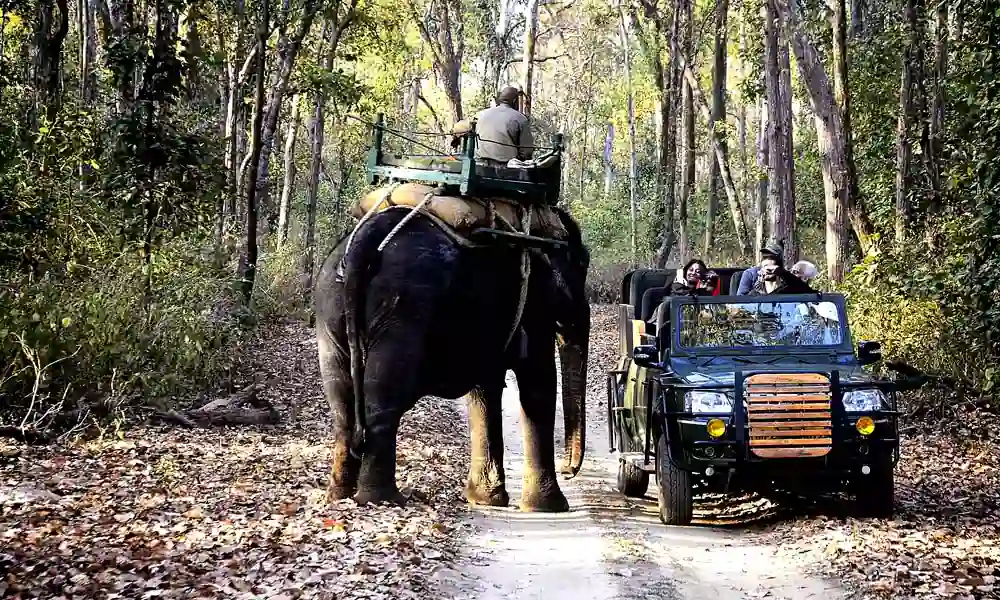
So… let’s talk numbers. Because if you’ve made it this far, you’re probably wondering what this experience is really going to cost.
As of the most recent details available (and fair warning, things can change based on the forest department or tourism board decisions), the cost of an elephant safari in Kanha National Park typically ranges between ₹1,500 and ₹2,500 per person for about an hour-long ride.
But it’s not a flat rate. There are variables — season, zone, group size, and sometimes who you ask at the forest gate counter. If you’re going as a small group, usually 4 people max are allowed per elephant. In that case, the total cost can run anywhere from ₹5,000 to ₹10,000 per elephant.
If you’re a foreign tourist, you might pay a bit more — in the range of ₹3,000 to ₹3,500 per person. It sounds steep, but… it’s also not something you can do just anywhere.
Pricing Table
| Visitor Type | Approx. Cost per Person | Group (4 max) | Notes |
|---|---|---|---|
| Indian Citizen | ₹1,500–₹2,500 | ₹5,000–₹7,000 | Depending on zone and time of year |
| Foreign Tourist | ₹3,000–₹3,500 | ₹7,000–₹10,000 | Camera fee extra |
| Children (under 5) | Often Free | N/A | May vary by zone/booking counter |
And that’s not all. There are additional costs you should factor in:
- Kanha National Park ticket price per person (varies by zone and nationality)
- Entry permits or ID-based verification (bring your Aadhar card, passport, or Voter ID)
- Camera/photography charges (especially if you’re bringing a DSLR or plan video shooting)
- Tips for your mahout or guide (not mandatory, but appreciated)
- Permit charges and safari member details, especially if you’re booking with a lodge or through a package
You might come across Kanha Jungle Safari packages online, but be cautious — elephant safaris can’t be booked online like jeep rides can. We’ll get into that next.
How to Book an Elephant Safari in Kanha?
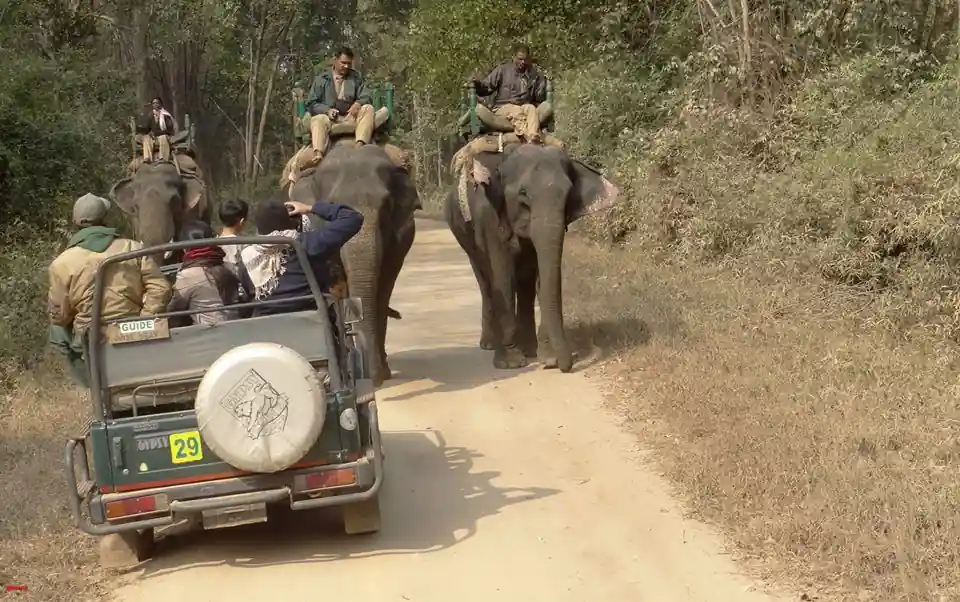
Here’s the thing nobody tells you in advance: you can’t pre-book elephant safaris online. That shiny “book now” button you saw? It’s probably for jeep safaris, not elephants.
The process is… a bit more old-fashioned.
You’ll need to visit the forest department counter in person, typically at Khatia Gate or Mukki Gate — ideally a day before your desired safari. And even then, availability isn’t guaranteed. Elephant rides are prioritized for official park use, VIP visitors, or wildlife researchers, and only after that are a handful of seats made available to the public.
Here’s how the booking process usually works:
- Arrive early (seriously… think 5:30 or 6 AM).
- Head to the safari booking counter at your chosen entry gate.
- Inquire directly with forest officials or the Park Field Director’s office about availability.
- Be prepared with all IDs — Aadhar, passport, or voter ID.
- Confirm details: Kanha National Park safari booking availability, timings, and price.
Some eco-resorts or jungle lodges near Khatia Jungle Camp or the Mukki Zone offer help with elephant safari bookings. If you’re staying in one of those, it might be worth asking them to guide you through the process.
Pro Tip:
- Weekdays are your friend. Less crowd, better chances.
- Avoid peak public holidays or festival weekends unless you have inside contacts.
- Ask your local safari guide — sometimes they know when tiger tracking might lead to an elephant safari opening up.
Is the Cost Worth It? What You Get from an Elephant Safari
This one’s subjective, sure. But let’s walk through it together.
For starters, elephant safaris in Kanha Tiger Reserve offer something you just can’t replicate in a jeep safari. You get to enter areas of the jungle that are otherwise off-limits. These are dense, deep sections… the kind where wild animals don’t just pass by — they live there. Quietly. Which makes the whole thing feel… sacred, almost.
You might end up just meters away from a Bengal Tiger, especially during tiger tracking when elephants follow trails deep into the core zones. You don’t get that kind of proximity from a jeep. And walking? That’s not even allowed in the core areas.
The ride itself is… peaceful. Slow. No engine noise, no honking or shouting. Just you, your elephant, your mahout, and the jungle.
If you’re into wildlife photography, this might be your golden moment. Imagine eye-level shots of swamp deer or glimpses of Indian leopards melting into the undergrowth. You have time to pause, observe, wait. That’s rare.
So… is it worth the ₹2,000 or so per person?
Honestly, if you’re the kind of traveler who doesn’t mind skipping the hotel buffet for one morning and is okay with the unpredictability, it’s absolutely worth it. You’re not just buying a ride. You’re buying access — to the inner rhythm of the forest, to spaces that aren’t open to just anyone.
And sometimes, to memories that don’t quite fit on Instagram.
Alternatives to Elephant Safari and Price Comparison
Let’s say the elephant safari doesn’t work out. Or maybe you’re on the fence about the ethics. You still have options.
Kanha National Park is big — we’re talking about 1,940 square kilometers of forest, grasslands, and tiger territory, spread across core and buffer zones like Mukki, Kisli, Sarhi, and Kanha zones.
1. Jeep Safari (Gypsy Safari)
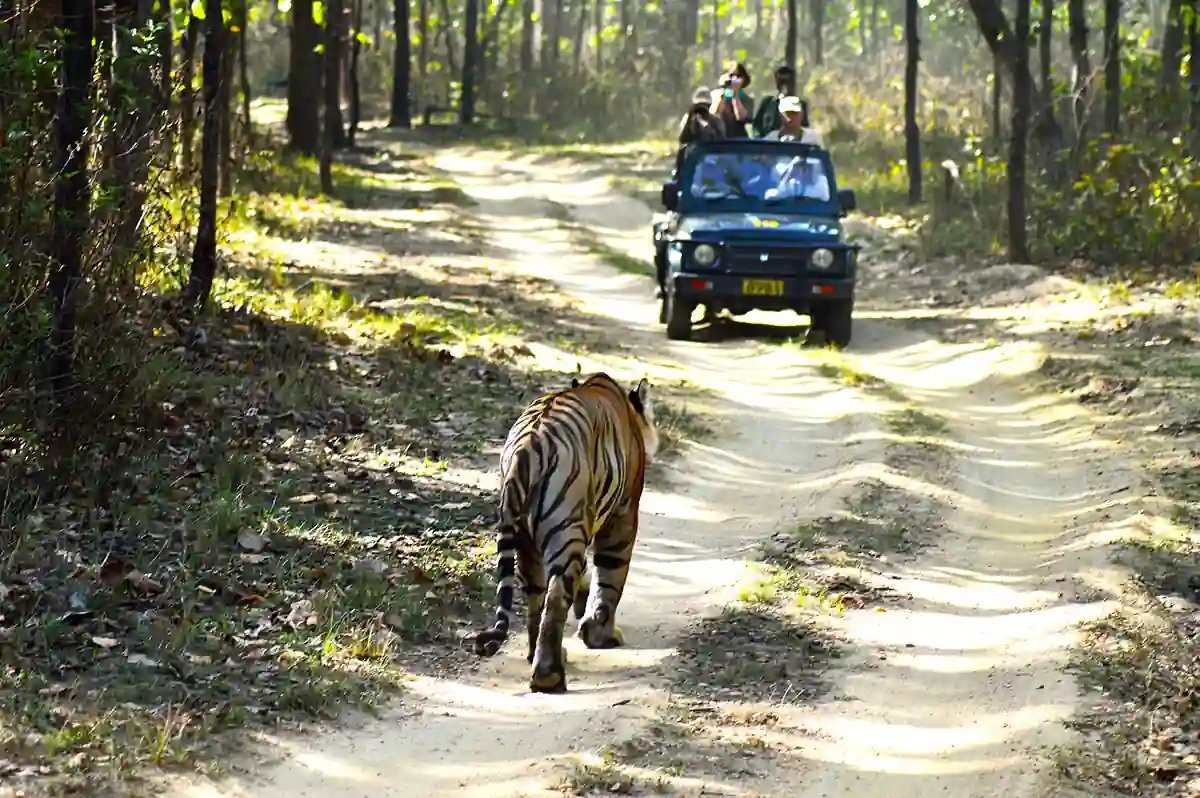
This is the most common — and usually easiest — way to explore Kanha. You ride in an open-top Gypsy, accompanied by a trained guide and a forest driver. These jeeps can take you deep into the Tourism Zone, passing watering holes, meadows, and known tiger trails.
- Kanha National Park safari booking price: around ₹1,500–₹4,000 per jeep (not including entry permits, guide fees, or camera charges)
- Safari ride timings: Two slots daily — morning (6–11 AM) and evening (3–6 PM), depending on the season.
- Online Safari Booking: Yes, available via the official forest department site or through registered travel agents.
2. Walking Safari (Buffer Zones only)

If you’re more interested in the small stuff — bird calls, termite mounds, paw prints — this one’s for you. These walks are available in the buffer zones and usually led by experienced naturalists.
- Availability: Mostly in the Khatia and Sarhi buffer zones
- Cost: Around ₹500–₹1,000 per person
- Experience: You won’t see tigers, but the serenity is unmatched
Comparison Table: Elephant vs Jeep vs Walking Safari
| Type of Safari | Cost (Approx.) | Access Level | Booking Method | Wildlife Spotting | Availability |
|---|---|---|---|---|---|
| Elephant Safari | ₹1,500–₹2,500 pp | Deep forest/core zones | Offline at gate | High (especially tiger) | Very Limited |
| Jeep Safari | ₹1,500–₹4,000/jeep | Tourism/core zones | Online or at gate | Moderate to High | Widely Available |
| Walking Safari | ₹500–₹1,000 pp | Buffer zones only | Lodge/Resort or gate | Low to Moderate | Seasonal |
So, yeah. If you’re weighing the cost versus what you’ll see and feel, the elephant safari is the most intimate… but also the hardest to access.
Ethical Concerns and Conservation Efforts
Now let’s pause for a second. Elephant safaris — while fascinating — aren’t without controversy. And it’s fair to ask… is it right?
There’s been ongoing discussion around the ethics of using elephants for tourism, not just in India, but globally. Concerns include overwork, limited rest, and questionable training methods in some places. However, Kanha National Park operates under the direct oversight of the forest department, and the elephants used here are government-owned, monitored, and cared for — not privately rented.
They undergo regular veterinary checks, follow strict schedules, and aren’t used during the hotter parts of the day or off-season months. Safari hours are short, and their diet and rest cycles are managed by jungle officials and handlers trained in elephant care.
That said… some travelers still feel conflicted. If you’re unsure, it’s okay to skip it and opt for jeep safaris or a wildlife photography walk instead.
But here’s a lesser-known fact: revenue from elephant and jeep safaris often helps fund conservation programs, support forest staff salaries, and bring employment to nearby communities. It’s part of the larger eco-tourism puzzle.
So if you choose to go, maybe see it not just as a ride… but as a way to contribute — consciously, and respectfully — to the jungle’s future.
Tips to Maximize Your Safari Experience
Alright, down to the practical stuff. Whether you go for an elephant safari or stick with a jeep, there are a few things you can do to really make it count.
Timing is Everything
- Visit between November and April — this is when the forest is most alive and sightings of the Big Cats, including the Bengal tiger and Hard Ground Barasingha, peak.
- Morning safaris tend to be more productive for wildlife sightings. The forest wakes up early.
Dress Smart
- Neutral colors like beige, olive, or grey. Avoid bright colors (and definitely skip the cologne).
- Wear layers — mornings are chilly, but it warms up fast.
- Bring a hat, sunglasses, and maybe even a light scarf for the dust.
What to Pack
- Binoculars (trust me, you’ll wish you had them)
- Extra camera batteries and memory cards
- A small water bottle (no plastic bags — they’re banned)
- Your ID card (Aadhar, passport, or Voter ID is required for entry permits)
Where to Stay
Consider eco-lodges near Khatia entrance gate, Mukki gate, or even the Sarhi Zone if you want to be close to the action. Some of these places offer bundled Kanha jungle safari packages, which include meals, guides, and assistance with safari booking.
Talk to People
Chat with your jeep driver, forest guide, or even the Park Field Director if you happen to spot them. Locals and staff often know when something’s happening — a tiger sighting, a surprise elephant ride, or a rare wild animal sighting. Sometimes a simple question leads to an unexpected opportunity.
Final Thoughts: Is It Just a Ride?
So, how much is elephant safari in Kanha National Park?
In rupees, somewhere between ₹1,500 and ₹3,500 per person… maybe more if you’re a foreigner, or less if you’re lucky. But if you’re asking in terms of value — real value — then it’s a little harder to measure.
Because what you’re buying isn’t just a seat on an elephant. It’s that hour in the forest when the world slows down. When the chirp of a parakeet or the rustle of dry sal leaves feels more urgent than your phone’s notifications back home.
Yes, Kanha National Park has jeep safaris, walking trails, and online booking systems for most things. But elephant safaris? They’re still a little wild. A little unpredictable. And sometimes… kind of magical.
If you manage to get a ride, savor it. Be still. Let the serene jungle move around you, not the other way around. And if not? There’s plenty more to explore — the Kanha zones, the Kisli gate, the core and buffer zones, and the energy of a place that inspired the original Jungle Book.
One last thing: plan ahead. Check Kanha National Park safari booking availability, stay close to the entry gates, keep your ID proof handy, and talk to the people who live and work there — the field director, the jungle guides, even the lodge staff. They often know more than any website.
And if you go… maybe let me know how it went.
Frequently Asked Questions
1. Is the elephant safari safe?
Yep, generally very safe. The elephants are trained and managed by expert mahouts and forest officials. Just sit still and follow your guide’s instructions.
2. How long does the ride last?
Usually around 45 minutes to 1 hour. Sometimes shorter if the safari is focused on tiger tracking near a specific location.
3. How much is elephant safari in Kanha National Park per person?
It ranges from ₹1,500 to ₹2,500 for Indian citizens and up to ₹3,500 for foreign tourists. Always check current safari tariff at the booking gate.
4. Can kids ride elephants in Kanha?
Children over the age of 5 are usually allowed, but very young kids might not be permitted for safety reasons. It depends on the guide and forest department policies.
5. Can I cancel or refund my safari ticket?
Since elephant safaris are booked offline at the gate, cancellation/refund policies vary. There’s no formal online ticket to cancel.
6. How to book night safari in Kanha National Park?
Night safaris are only allowed in select buffer zones and not on elephants. You’ll need to book them through the forest department or via your lodge.
7. What documents do I need for the booking?
Carry valid ID proof like Aadhar card, passport, or voter ID. You’ll need it for the permit charges and safari member details.
8. What are the Kanha National Park safari timings?
Morning safari: 6 AM to 11 AM
Evening safari: 3 PM to 6 PM
These vary slightly with the season.
9. What’s the Kanha National Park contact number?
You can reach the forest department at +91-7612-254291 (Field Director’s Office) or check the official MP tourism website for updates.
10. How do I get to Kanha?
The nearest airports are Jabalpur Airport, Raipur Airport, and Nagpur. Closest railway stations include Bilaspur Junction, Gondia, and Jabalpur.
Recent Posts
 Tubeseferi: 7 Must-Know Features for Smart City Travel in 2025
Tubeseferi: 7 Must-Know Features for Smart City Travel in 2025 What Is Antolohe? Hidden Travel Meaning Revealed for 2025
What Is Antolohe? Hidden Travel Meaning Revealed for 2025 How to Become a Travel Agent Without Experience?
How to Become a Travel Agent Without Experience? 15 Best Airlines for Long Flights in 2025: Comfort, Cuisine, and Sky-High Service
15 Best Airlines for Long Flights in 2025: Comfort, Cuisine, and Sky-High Service Day Trips from Buenos Aires: Surprising Routes Off the Tourist Trail
Day Trips from Buenos Aires: Surprising Routes Off the Tourist Trail




